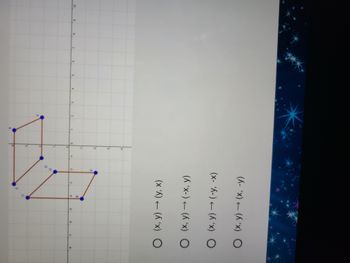Algebra & Trigonometry with Analytic Geometry
13th Edition
ISBN:9781133382119
Author:Swokowski
Publisher:Swokowski
Chapter1: Fundamental Concepts Of Algebra
Section1.1: Real Numbers
Problem 1E
Related questions
Question

Transcribed Image Text:Which transformation turns the pre-image ABCD into the image A'B'C'D'?
O X, y) → (y, x)
ОЖУ) — (у, х)
ОЖУ) — (-х, -у)
(х, у) — (-у, х)
o search
O HI
Expert Solution
This question has been solved!
Explore an expertly crafted, step-by-step solution for a thorough understanding of key concepts.
Step by step
Solved in 2 steps with 1 images

Follow-up Questions
Read through expert solutions to related follow-up questions below.
Follow-up Question
Which transformation turns the preimage ABCD into the image A'B'C'D?

Transcribed Image Text:**Graph Analysis on Transformation and Symmetry**
The image presents a mathematical graph and a set of instructions likely related to geometric transformations or symmetry.
### Graph Description:
On the left side of the image, a Cartesian Coordinate System is displayed with a distinctive geometric figure drawn across the quadrants.
- **Geometric Figure**: The shape resembles a series of connected line segments forming a letter-like structure (possibly an angular 'S') with the vertices marked by blue dots.
- **Vertices**: The vertices of the shape are located at the following coordinates:
- First set: (-1, 0), (-1, 1), (0, 1)
- Second set: (0, 0), (-1, -1), (0, -1), (0, -2)
### Transformation Instructions:
On the right side of the image, there are symbols and arrows that suggest instruction for geometric transformations:
- Each column represents a set of transformations applied to the figure.
- Arrows point in specific directions, potentially indicating rotations or reflections.
- The first arrow points downward with an "X" symbol.
- The second arrow points to the right with an "X" symbol.
- The third arrow points upward with an "X" symbol.
- The fourth arrow points to the left with an "X" symbol.
These might indicate certain fixed points or axes of transformation (rotation/reflection). Below each arrow, there is a symbol of a circle.
### Explanation:
1. **Rotation/Reflection**: The arrows and symbols are possibly referring to rotational movements (clockwise or counterclockwise) or reflections across specific axes.
2. **Symmetry**: The shape might be tested for symmetry with respect to the x-axis, y-axis, or origin as shown by each column's specification.
This setup can be used for exercises in geometric transformations such as rotating a shape 90 degrees clockwise or counterclockwise, reflecting it across the x or y-axis, or investigating symmetry properties. Students can use these clues to transform the given figure and check for invariance or change in orientation/position.
It is likely that the goal is to understand the impact of these transformations on the initial geometric shape and to identify patterns or invariant properties through visualization.
Solution
Recommended textbooks for you

Algebra & Trigonometry with Analytic Geometry
Algebra
ISBN:
9781133382119
Author:
Swokowski
Publisher:
Cengage

Elementary Linear Algebra (MindTap Course List)
Algebra
ISBN:
9781305658004
Author:
Ron Larson
Publisher:
Cengage Learning

Holt Mcdougal Larson Pre-algebra: Student Edition…
Algebra
ISBN:
9780547587776
Author:
HOLT MCDOUGAL
Publisher:
HOLT MCDOUGAL

Algebra & Trigonometry with Analytic Geometry
Algebra
ISBN:
9781133382119
Author:
Swokowski
Publisher:
Cengage

Elementary Linear Algebra (MindTap Course List)
Algebra
ISBN:
9781305658004
Author:
Ron Larson
Publisher:
Cengage Learning

Holt Mcdougal Larson Pre-algebra: Student Edition…
Algebra
ISBN:
9780547587776
Author:
HOLT MCDOUGAL
Publisher:
HOLT MCDOUGAL

Trigonometry (MindTap Course List)
Trigonometry
ISBN:
9781337278461
Author:
Ron Larson
Publisher:
Cengage Learning